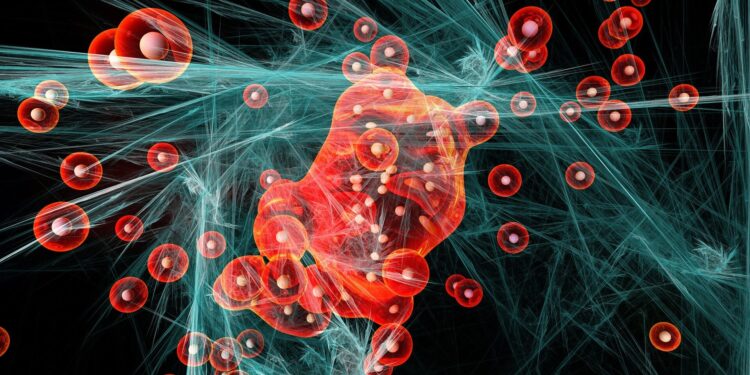Credit: Pixabay/CC0 Public domain
The chemical industry has long been shadowed by unwanted images of bloated smokestacks and pipes spewing toxic effluent. Modern manufacturing practices have done much to mitigate the industry’s environmental impact, but there is still room for improvement.
Making chemistry more environmentally friendly is a passion and major research focus for Caltech’s Karthish Manthiram, professor of chemical engineering and chemistry and William H. Hurt Fellow.
In an article published in the journal ScienceManthiram’s lab describes the development of a catalyst to produce a widely used chemical feedstock without the toxic and hazardous chemicals normally needed to produce it.
This chemical raw material, propylene oxide, is an organic compound used in a variety of applications, including the manufacture of foams, plastics and antifreezes, as well as for disinfection and sterilization. Traditionally, propylene oxide is produced by reacting propylene with hypochlorous acid or hydrogen peroxide. Each has its own drawback.
“With hypochlorous acid, you end up with a chloride byproduct that you release into the environment. For this reason, there are fewer and fewer permits being issued to allow factories that use the hypochlorous acid process “, explains Manthiram. “This has forced people to turn to peroxide-based processes, but this presents a huge safety challenge. Any time hydrogen peroxide comes into contact with organic compounds, there is a risk of imminent explosion.”
The group’s goal was to develop a safe method of producing propylene epoxy that would not produce environmental releases or have a significant carbon footprint. Manthiram explains that the team began by looking for a catalyst that could produce propylene epoxide using the oxygen atom found in a water molecule. The only side product would be hydrogen gas, which can be used as fuel or in the manufacture of other chemicals.
“The principle was that the water is safe,” he says. “It doesn’t present an inherent safety hazard and the process doesn’t produce any environmentally harmful side products. Instead, you produce hydrogen, which is something we need to produce more of in the future. is where we started.”
The group focused on two catalysts: platinum oxide and palladium oxide. Both performed the reaction the team wanted, but not well enough to be useful. Platinum oxide produced propylene epoxide at high rates, but in a disorderly manner, creating many unwanted side products. In contrast, palladium oxide produced propylene epoxide with fewer side products, but rather slowly.
Manthiram says the solution was to combine the two catalysts.
“Putting the two together ended up solving the problem,” says Minju Chung, lead author and former postdoctoral researcher at the Georgia Institute of Technology, now at MIT. “Then we spent a lot of time understanding why this blend works better. It’s not a simple explanation.”
Using X-ray absorption spectroscopy (a technique for revealing the atomic and electronic structure of materials by bombarding them with X-rays), researchers determined that in a mixture of platinum oxide and palladium oxide , platinum exists in a state that makes it a more effective catalyst.
“It turns out that one of the most dramatic effects of going from platinum oxide to palladium-platinum oxide is that you can stabilize the platinum in a higher oxidation state,” says Manthiram. “When in a higher oxidation state, the oxygen attached to platinum is more electron deprived, making it more reactive with electron-rich propylene. We see across a range of experiments that stabilizing platinum in a higher oxidation state leads to a significant reduction of oxygen in platinum.Improved rates and efficiencies of propylene epoxidation.
With the new catalyst, the production rate of propylene oxide is 10 times higher than before and the efficiency is increased by 13 percent, says Manthiram.
Manthiram says future research will focus on testing the catalyst to see how it can be transferred from a laboratory to an industrial environment. This will require analyzes examining how long the catalyst lasts before degrading and its performance on a larger scale, as well as developing a process to remove propylene epoxide from the system as it is produced. .
“It’s time to take this material out of this fundamental scientific context,” he says. “This is going to be really enlightening for us because it will show us what are the next things we should be working on.”
The article describing the work, “Direct Epoxidation of Propylene via Water Activation on Pd-Pt Electrocatalysts,” appears in the January 4 issue of Science.
More information:
Minju Chung et al, Direct epoxidation of propylene via water activation on Pd-Pt electrocatalysts, Science (2024). DOI: 10.1126/science.adh4355
Provided by California Institute of Technology
Quote: Research team combines two catalysts to make routine chemical production safer and more environmentally friendly (January 5, 2024) retrieved January 5, 2024 from
This document is subject to copyright. Apart from fair use for private study or research purposes, no part may be reproduced without written permission. The content is provided for information only.



